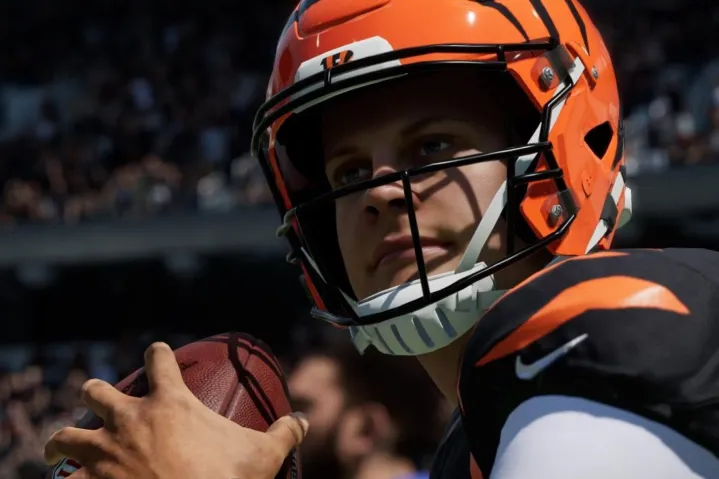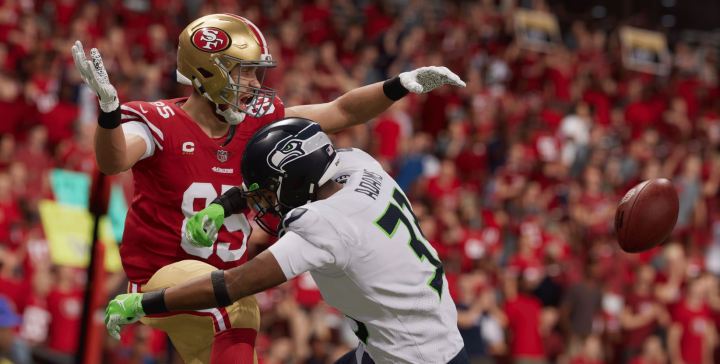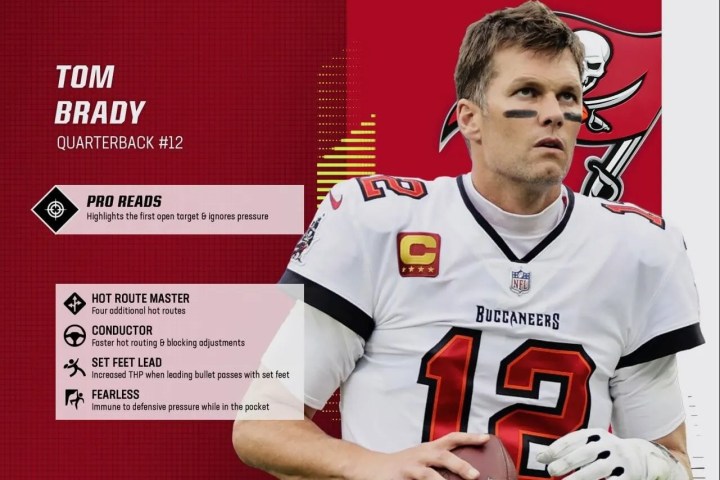To honor the late, great John Madden, EA dedicated 2022’s edition of the perennial NFL video game franchise to — perhaps — the most important man to ever step onto the football field. Madden NFL 23 also makes several quality-of-life improvements to help turn the meandering series in the right direction.
Players have more visual cues in the passing game, giving them more control over their quarterback, and the defensive AI doesn’t get cooked on every crossing route — though these boosts don’t mean anybody can pick up and play the game. With a few helpful Madden 23 tips and tricks, new players can get a better grip of how to succeed between the hash marks while returning players shake off the rust.
Here’s everything you need to know about new features in Madden NFL 23, including total-control passing, the “hit everything” tackle system, and the hidden mechanics that developers didn’t tell you about.
Recommended reading:
- Best sports games for PS5
- The best games on Xbox Game Pass for 2022 (Right Now)
- The best multiplayer games on the PS5
New passing mechanics in Madden 23

Leading up to Madden 23’s release, all we heard about was the new “skill-based passing” mechanic. While the phrase “skill-based” triggers some gamers, the updated passing mechanics in Madden 23 spurred excitement in the community. So how do they work, are they worth using, and how can players leverage them on the field?
Passing the rock in Madden 23 breaks into three options: Placement and Accuracy, Placement, and Classic.
Placement and Accuracy bring all the new features onto the field. You’ll see a power meter over the QB’s head, a gray target area, and a reticle around your intended receiver. To throw an “accurate” pass, you’ll need to release the receiver icon in the blue area on the power meter. This, in turn, means all your “perfect accuracy passes” will be bullet passes, which isn’t always ideal.
Not hitting the blue box doesn’t mean you’ll throw an errant ball. It just means you might miss a tight window by a few hairs. Holding the receiver button like you’re throwing a traditional bullet pass still throws a solid ball based on your QB’s accuracy rating, the pass rush, their superstar abilities, and if they’re on the run.
The target reticle is where things get interesting in Madden 23. The placement passing mechanic displays a gray circle around your target receiver. Within that area, you have a little more control over how you lead them. If you can get the sensitivity and timing down, you can put balls where only your receiver can catch them. That, or the ball hits the ground or sails out of bounds.
The Placement option takes the accuracy meter out of the equation. Instead, you’ll just focus on where you want to put the ball. We highly recommend playing through the new passing mechanics tutorial to understand which buttons to press when passing the football. You’ll find this tutorial in the Skills Trainer menu under the Advanced Techniques drills.
Classic passing is what it sounds like. Choosing this setting removes the accuracy meter and the reticle from the passing game. Instead, you can throw the ball like you always have. So, which is the best one?
This may sound disappointing, but the new “passing mechanics” feel like visualizations of the classic passing game. When using placement passing, you have milliseconds to place the ball within the reticle, ultimately leading receivers as you usually would. Furthermore, the accuracy meter takes your eyes off the most important thing: the field. And, there are so many button combos to press if you want a low, outside-the-reticle pass that going through the motions just feels unnecessary.
There are numerous things to read and pay attention to when throwing the ball, between coverages, blitzers, dropping corners, and backpedaling safeties. If you can read coverage, the new passing mechanics feel very underwhelming. The verdict? Stick with classic passing, learn to read coverages, and know when to throw the ball away or take your checkdowns (a crucial tip we’ll touch on later).
New tackling mechanics in Madden 23

While the new passing mechanics feel lackluster, the new tackling mechanics are a win for offenses everywhere. It’s hard to explain the “hit everything” feature. In Madden 23, it feels like developers took more intangibles into account, such as angles, player size, momentum, and speed.
Before, some no-name linebacker could shed a block and take down Derrick Henry with some lame animation. Now, Derrick Henry makes that no-name linebacker want to retire early. Of course, Aaron Donald can always put Derrick Henry, or any other bruising running back, in their place.
The new quick-time tackle event adds an interesting layer as well. You’ll always mash the X button (on PlayStation, A on Xbox) during the event, so whenever you initiate a tackle, just start mashing. Likewise, when you’re about to get tackled, start mashing X to either stiff-arm the tackler or get a head-start on the quick-time event. Perhaps that’ll change in the future, forcing you to mash different buttons to break tackles.
Understanding defensive AI improvements
Passing and tackling aside, the most significant improvement to Madden 23 is the defensive AI, specifically zone defenders and pass rushers. There’s no telling how many controllers got thrown across the room every time someone hit their opponent with deep crossers in Madden 22. It was almost formulaic: Roll out with Josh Allen or Lamar Jackson, and hit a 30-yard cross down-field while the safety backpedaled into no-man’s land. Thankfully, Madden 23 put the kibosh on that — for the most part.
Unless someone threatens to get behind your safeties, they won’t aimlessly backpedal in Madden 23. Instead, they’ll come up on those crossing routes, putting them in a better spot to break on the ball once the QB throws it. So far, the only time we notice our deep crossers getting open is when the defense is in single-high man or a zero-blitz. That said, our receivers must be fast enough to pull away from their man defender.
Take your checkdowns
Checkdown throws (drags, spots, and short RB routes) are more important than ever in Madden 23. First, the defensive AI won’t let your receivers get open without earning it. You can still get someone wide open on a corner route or deep post if you make the right reads. Otherwise, you’ll need to hit those quick drag routes across the field or your RB on an out route when your primary read isn’t open. Just be careful, and ensure a flat defender isn’t waiting to pick the ball off.
Secondly, the pass rush in Madden 23 is ruthless. You can’t just scramble out of the pocket and throw deep crossers all day. Instead, you’ll need to stand in and make your reads. That’s not to say designed QB rollouts are totally ineffective. They’re a part of the game and a reason why QBs like Patrick Mahomes and Josh Allen are so dangerous. You’ll have less time to run to the sideline as edge rushers break off their blockers and run you down.
Don’t block TEs and RBs
You don’t have that much time in the pocket this year either. Given the defensive AI improvements, quick throws and checkdowns will dominate Madden 23. You might think the answer to ruthless pass rushers is to block using the TE or RB. Don’t.
Even the best TEs like Travis Kelce and George Kittle can’t pass block to save their careers. They’ll get flattened off the line every time, so you’re better off putting them on a route. In fact, the best pass-blocking TE in the game is Tommy Hudson, a 62 OVR TE for the Tennessee Titans with 66 pass blocking.
The same is true for blocking with your RB. Even Derrick Henry will get leveled by incoming linemen and linebackers. You’re better off sending your RB on a quick route or calling an audible for a screen pass if you feel a blitz coming. For reference, the best pass-blocking RB in the game is Kerryon Johnson, a 69 OVR free agent with 70 pass blocking.
For reference, the better RTs and LTs have pass-blocking stats in the mid-to-high 80s.
Best coaching adjustments in Madden 23

Every Madden YouTuber gets the same question on every video: “What are your coaching adjustments?” While some coaching adjustments may change depending on the playstyle and situation, you can set and forget most of them in Madden 23. As an added bonus, EA actually listened to the community and added coaching adjustments to practice mode. Now you can play around with all the settings without the stress of managing an actual game.
Let’s dive into the best coaching adjustments in Madden 23 for offense and defense.
Offensive coaching adjustments
We don’t need to get too in-depth with offensive coaching adjustments. Leave deep and intermediate pass-catching on balanced, and make the decision yourself once the ball is in the air. Tell the receiver to Run After Catch (RAC) with Square if you’ve led them upfield or if nobody is around. Have them make a conservative catch with X near the sidelines to toe-tap or when running across the middle to avoid big hits. Finally, trigger aggressive catches with Triangle during one-on-one toss-up throws downfield or in the back of the end zone.
Leave your blocking adjustments balanced. Your linemen don’t hold their blocking assignments long, and the conservative setting makes it worse. Setting your blockers to aggressive only triggers more holding penalties without much to gain.
You can mess with the ball carrier adjustments depending on the in-game situation. When you’re trying to burn the clock in the fourth quarter, set this to conservative to avoid costly fumbles. On the other hand, if you’re down in the fourth quarter and need to break more tackles, set this to aggressive. You increase your chance of a fumble, but, at this point, you don’t have much to lose.
Defensive coaching adjustments
Every Madden player will tell you something different between zone drops, tackling, and auto-flip adjustments. So, here are the best defensive coaching adjustments in Madden 23 (in our humble opinion).
Defensive auto-flip: On or off?
Leave defensive auto-flip on. This will ensure your defense lines up correctly without leaving massive holes on the field. Some YouTubers will tell you about some glitch-blitz that requires manual flipping. While that glitch-blitz will work once or twice, you can’t run it all game. You’ll get cooked for a big play if you forget to turn auto-flip back on.
Auto-alignment
Alignment settings depend on the type of defense you like to run: zone-heavy or man-heavy. You can often leave the alignment setting alone, and your players will line up according to the play art. However, this can tip your opponent to what type of defense you’re running (cover 2, cover 3, man 1, man 2).
Instead, you can base align to have your defense line up according to their position on the field. Now, even if you come out in a cover 2, your defense might look like a cover 3. The only downside is your flat defenders might be out of position. Instead of playing a few yards off the line (which is where they’re supposed to cover), they’ll play 10 yards off the line, leaving receivers open on quick slants and smoke screens.
Ball in air defense
Keep this setting on Play Ball to trigger more interceptions, especially during the early/mid-game. As the game winds down, consider switching back to Balanced to avoid giving up anything significant. If you need a turnover at the end of the game, your opponent will likely run the ball, only passing on third down if they absolutely have to. Keep this set to Balanced in these situations to increase your chances of forcing a fourth down.
Cornerback Matchups and Option Defense
Speed. Speed. Speed. Tyreek Hill will cook the best corners in the game. You’re better off having your fastest corners matchup with their quickest receivers. If you’re playing a zone-heavy defense, you can get away with leaving this on Balanced. Otherwise, man-heavy defenses need all the speed they can get.
For your Option Defense settings, leave it on conservative to focus on the QB. Scramblers like Lamar Jackson and Josh Allen usually break for bigger runs than the RB diving up the middle.
Strip Ball and Tackling
Fumbles are more common in Madden 23, but that’s primarily due to big hits and the new Hit Everything system. So, leave your Strip Ball setting on balanced but set your Tackling to aggressive. Aggressive tackling doesn’t come with an increased chance of penalties like aggressive strip does (aggressive strip increases the chance of a face-mask penalty).
You might miss a tackle or two, but one turnover is better than two missed tackles. Set your tackling back to Balanced once your opponent enters field goal range, where a missed tackle could mean the difference between three and seven points.
Zone Drops and Coverage
Madden players will argue about zone drops until the sun comes up. Ultimately, these settings will change game-to-game. There’s no “set it and forget it” distance for flats, curls, and hooks. Instead, you need to read what your opponent likes to do and change your drops accordingly.
It also depends on where you are on the field. Setting your flats to 15 yards might help cover corner routes and crossers, but those defenders must come up once your opponent enters the Red Zone.
If you want to keep everything in front of your defense (basically covering all intermediate and deep routes), set all three zone drops to 10 yards. Your deep zones will cover deeper routes like corners, go-routes, and crossers, while your flats, hooks, and curls keep those intermediate routes on lock. Yes, RBs out of the backfield and drags behind the line will get open, but they won’t gain many yards.
The defensive AI upgrades make zone drop settings less important this year. Instead, you can play around with them as the game progresses, take away something your opponent likes to do, and force them into uncomfortable situations (cue the tiniest smirk from coach Belichick).
As for the Zone Coverage option, Madden 23 allows you to play Match Coverage on every play (if you so choose). In short, Match Coverage blends zone and man. AI defenders will man up on receivers entering their zones, which can confuse the heck out of any Quarterback. Then again, they’ll often vacate their zones, leaving them wide open if the pass rush doesn’t get home in time.
Hot Route Master: the best QB skill?

Madden 23 nerfed Escape Artist into the ground. Instead of being the meta superstar ability, players who want Escape Artist on their scrambling QBs must earn it as an X-factor. So with Escape Artist out the window, is Hot Route Master the best passive QB trait in Madden 23?
Hot Route Master unlocks four additional hot routes for your receivers and running backs. But remember, the available routes depend on where they are on the line of scrimmage.
A TE on the line has different routes than a TE split out wide. If you move that TE out wide, you can unlock those other routes. You can also motion the TE after setting their unique inside route to have them run it along the perimeter. Trail and Texas routes are two good examples.
The best part of Hot Route Master is the ability to improvise flood and levels concepts on any play. Both concepts feature short, medium, and deep routes to one side of the field. So, when Tom Brady walks up to the line and reads Cover 2, he can hot route into a flood concept and hit his TE in the corner or his RB in the flat.
Regarding the default QBs in the game, Tom Brady is the only QB with Hot Route master. However, you can always add HRM to your MUT QB, Face of the Franchise QB, or Franchise QB through the Abilities tab on their player profile.
Set your audibles
Changing plays at the line of scrimmage is the most important part of running your offense. Every play you call comes with four default audibles, including a mix of run, pass, and play action. But sometimes, those plays won’t work with what the defense is showing. And unless you have a Hot Route Master QB, your play is likely over before you snap the ball.
Once you find a playbook you like, head into practice mode and run through every offensive formation available. Figure out which ones let you motion receivers and which have audibles you like switching to. Then, set your audibles to have Cover 2, Cover 3, Blitz, and Man beaters.
Remember, you can also switch between formations at the line. So if the defense is showing blitz, it’s best to audible into a new formation that puts your QB in the gun.
For example, in the 49ers playbook, you can switch between Singleback Deuce Close (QB under center) and Gun Deuce Close (QB in the Gun) without your entire offense moving around. If you pre-set audibles for both formations, you essentially give yourself nine plays to run based on the defense. As a bonus, flipping Gun Deuce Close just puts the RB on the other side, allowing you to quickly flip and run the play.
Some formation audibles depend on the personnel, so you’ll need to mess around in practice with the desired team and playbook. If you have two speedy pass-catching TEs, you can come out in a heavier set and then audible into a spread offense. Meanwhile, the CPU will likely deploy linebackers to counter anticipated run plays, allowing you to pass all over them.
When setting your audibles, consider always having an:
- Inside run play
- Outside run play
- Flood concept
- Screen Pass
Never choose a play that’s already in your audibles. That way, you have a minimum of five plays available at the line of scrimmage. If you’re wondering how to edit your audibles in the play call menu:
- Press L2 in the play call menu to bring up your audibles for that formation
- Press X on the play you’d like to change
- Select a new play from the next menu
- Repeat this for all four audibles
We wish there was a way to lock your audibles between games. Unfortunately, you’ll need to set these every time you start a new game. Repetition helps you remember which formation and plays to change. But don’t go crazy trying to change everything on the first play. Use the first drive of a game to set a handful of formations, keeping your eye on the play clock to avoid a Delay of Game penalty. Then, set different formations during each subsequent drive until everything is in place.
This isn’t to say you need to change audibles for every formation in the playbook. Just stick with the formations you like, ensuring you have enough to keep your opponent guessing between drives.
The same concepts apply defensively, but they aren’t that in-depth. Just make sure your defensive formations have a Cover 2 Man, Cover 2 Zone, Cover 3, and a blitz package ready to deploy. If the offense comes out in a bunch formation or with the receivers tight to the line, audible into a zone defense to avoid getting beaten in man coverage. Spread offensive formations are easier to defend man-to-man, assuming you have the speed to match.
Editors' Recommendations
- The best games you can beat in a day
- Best PS5 game deals: discounts on the best games of 2023
- Best PS5 deals: Console bundles, top games, and accessories
- The 5 best PlayStation Portal alternatives in 2024
- Best gaming console deals: cheapest prices on PS5, Xbox S and X and Switch



